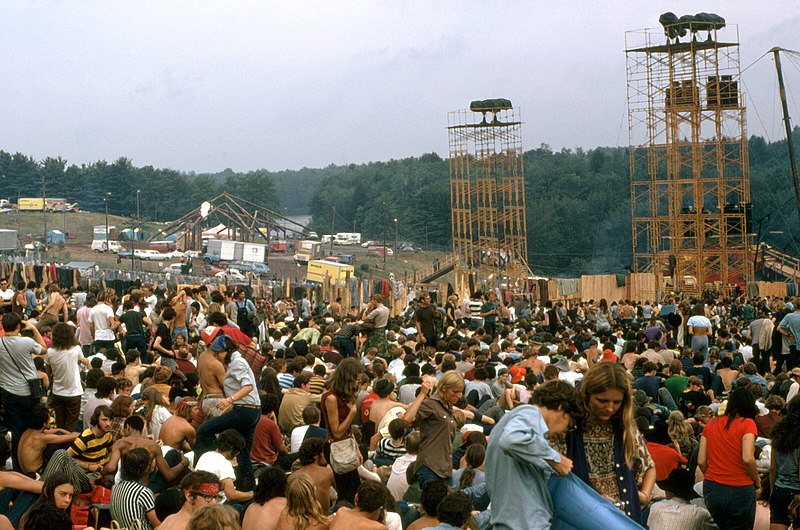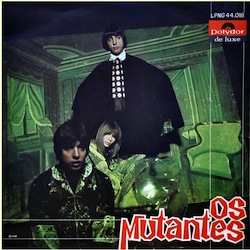Counter-Culture: The Top 100 Songs of the ’60s

 40. Serge Gainsbourg and Jane Birkin – “Je t’aime…moi non plus”
40. Serge Gainsbourg and Jane Birkin – “Je t’aime…moi non plus”
from Jane Birkin et Serge Gainsbourg (1969; Fontana)
Serge Gainsbourg nonchalantly punctured taboos as part of his daily nutritious breakfast, and his most popular track heavily informed erotically themed pop that came after (or, ideally, at the same time, ha-ha). “Je t’aime” originally featured Brigitte Bardot on coos, groans and writhing, but her husband at the time wasn’t cool with its release. (Unfounded reports claimed she wasn’t exactly acting.) Gainsbourg finally recorded the official version with English girlfriend Jane Birkin, and the resultant audio sexcapade caused more than a little concern in more sanitary audiences. The writer claimed “Je t’aime” was more complicated than it sounds, later calling it a chanson anti-biase (“anti-fuck song”) about the low ceiling of physical love. No word on whether Gainsbourg also sold Florida swampland and/or bridges. – PP
 39. Os Mutantes – “A Minha Menina”
39. Os Mutantes – “A Minha Menina”
from Os Mutantes (1968; Philips)
Os Mutantes translates from Portuguese to the relatively easy to figure out “The Mutants,” which is more or less what the Sao Paolo, Brazil band was. Their blend of homemade-fuzzbox psych and uniquely Brazilian sounds made them the most vibrant and bizarre of the Tropicália bunch, serving as a backing band for Caetano Veloso for a short time while exploring a peculiar acid-laced form of pop music that they pioneered, rarely repeating an idea more than once. Their best idea was turning this Jorge Ben samba standard into a celebratory party-garage trip-out, making a simple love song into one of psychedelia’s most inspired and fun moments. – JT
 38. Electric Prunes – “I Had Too Much to Dream Last Night”
38. Electric Prunes – “I Had Too Much to Dream Last Night”
from The Electric Prunes (1967; Reprise)
The Electric Prunes were a self-described “free-form garage” band, and to their record label’s dismay put more emphasis on experimenting than churning out hits. So the songwriting team of Nancie Mantz and Annette Tucker was brought in with this ode to intoxicated love affairs, as a means of putting the band back on track. Tucker originally wrote the song as a piano ballad, took inspiration from the Rolling Stones and made a few changes before it fell into the band’s hands. A few beautiful accidents in the studio and this classic was born, with its raw psychedelic glory. It became the band’s calling card. – WL
 37. Donovan – “Hurdy Gurdy Man”
37. Donovan – “Hurdy Gurdy Man”
from The Hurdy Gurdy Man (1968; Epic)
Had history left Donovan’s “Hurdy Gurdy Man” alone, it likely still would have had a comfortable place in the Summer of Love canon, its mixture of Sitar treatments, acid-rock guitar riffs, heroic drum fills and Leslie-effect vocals elevating Donovan from epistle-to-hippy-dippy post-British Invasion folkster into something more like a rock god. But history didn’t leave it alone. First The Butthole Surfers mutilated it with their own bad-trip sound filter in the ’80s, and with David Fincher’s 2007 thriller Zodiac, it ended up scoring a pretty harrowing murder scene. The unsettling nature of the song was always there, of course—those vocal effects shouldn’t sit right with anyone paying close attention. Something about an enchanted troubadour “singing songs of love” is ripe for a reveal of its sinister underbelly. – JT
 36. The Who – “My Generation”
36. The Who – “My Generation”
from My Generation (1965; Brunswick)
In the 60s, angst and ennui reigned over the teens of the times. The adolescents were misunderstood, and everyone above the age of 19 just didn’t get it. To truly explain the frustration with adults, English rock band The Who took to their respective instruments and proclaimed the truth about their generation, complete with some cheeky stutter-talk imitations of the drug-addled Mods. Writer and guitarist Pete Townshend reported that his inspiration for the song was Mose Allison’s “Young Man Blues,” but their own anthem surpassed their own inspirations. The Who’s honest and pompous exploration of rebelling through music was a staple of the rising mod culture of the time. – VC
 35. Miles Davis – “Shhh/Peaceful”
35. Miles Davis – “Shhh/Peaceful”
from In a Silent Way (1969; Columbia)
On February 18, 1969, Miles Davis officially went electric. Throughout the ’70s he’d essentially stay there, fusing the drive of rock with the improvisatory nature of jazz and increasingly making it sound heavier and weirder in the process. But this is his most beautiful and pure fusion of electric sounds with jazz essence, an 18-minute composition that used tape edits to build structure where otherwise the track might have simply kept on blasting toward the cosmos. The neat trick about it is that the electricity here is more of a suggestion than an outright statement. You can feel the charge on your skin even when you can’t hear it, and that’s part of Davis’ genius: He didn’t have to overdo anything—like his own instrument, the trumpet, which he uses sparingly—to leave a big impact. This coming a good 15 years and multiple innovations into his career. As he bluntly said to a politician’s wife, once, when she questioned his credentials: “Well, I changed music five or six times, so I guess that’s what I’ve done.” – JT
 34. Jefferson Airplane – “White Rabbit”
34. Jefferson Airplane – “White Rabbit”
from Surrealistic Pillow (1967; RCA Victor)
A loving ode to turning on, tuning in, and dropping out wrapped in an Alice In Wonderland allegory on an album called Surrealistic Pillow. Do you realize how much quality has to go into something like “White Rabbit” in order to not be denigrated as some sort of one-off joke produced by too many sleepless nights or as some sort of jaded parody signifier of a generational backwards glance from future generations? To identify with this song subtly nodded that you were fine with life as people knew it melting into the horizon for a few hours, that your mindset wasn’t set, and that sure, maybe you had to break a few laws to find some inner truths. Put more succinctly? Feed your head. – BR
 33. Them – “Gloria”
33. Them – “Gloria”
(1964; Decca)
Part bar-band staple and part rock ‘n’ roll charter, the song that introduced Van Morrison to the world is a rave-up whose influence is almost outsized considering its straightforward attack. The two-chord testimony of “Gloria” is garage lust as uncompromising as anything of its time: Morrison’s halting, faltering delivery uncovers every membrane of his desire, the same way Delta bluesmen sang about hellhounds and desperation. The sharp edges of Morrison’s vocals were something he never recaptured on record again, as if he fully intended to leave that roughness in its youth. “Gloria” is also something of a blank canvas for exploring the competitive passions of sex and spirituality—her name is probably not an accident. – PP
 32. Townes Van Zandt – “Waitin’ Around to Die”
32. Townes Van Zandt – “Waitin’ Around to Die”
from For the Sake of the Song (1968; Poppy)
Townes Van Zandt may very well be the epitome of the “tortured artist” archetype. Diagnosed with bipolar disorder, he spent decades touring dive bars, often drunk or strung out on heroin in the process, before finally succumbing to cardiac arrhythmia as a result of lifetime alcohol abuse. It’s important not to let this overshadow his music, however, but to give it context. Widely considered to be one of the greatest and most influential country songwriters, Van Zandt dealt almost primarily in sad songs, and “Waitin’ Around To Die” may be his best one. The first version, released on 1968’s For the Sake of the Song, is by far the most extravagant of the three, even echoing Lee Hazlewood. It’s still excellent, but version two, released on 1969’s Townes Van Zandt, is more dusty, forlorn. (And a line like “Now I’m out of prison, I got me a friend at last / His name’s codeine, he’s the nicest thing I’ve seen” really works better in a stripped-down folk context.) Version three is a live rendition on 1977’s Live At The Old Quarter in Houston, and easily the best, as the intimate atmosphere of the bar brings out the inner despondency even further. – BB
 31. The Band – “The Night They Drove Old Dixie Down”
31. The Band – “The Night They Drove Old Dixie Down”
from The Band (1969; Capitol)
Written in 1969 by Robbie Robertson but popularized by an inadequate yet commercially more appealing cover in 1971, The Band’s “The Night They Drove Old Dixie Down” is a predominantly Canadian group’s tribute to the final days of the south and its sufferings at the conclusion of the American Civil War. A true, Americana folk piece, “Dixie” is the epitome of what our nation musically identifies with. It’s a fact-checked, nation-abiding, borderline chantey of a track, filled with brooding melodies at a slow foot-stomping pace. But “Dixie” is more than just a lovely ballad of narrated stories and ideas. In a sense, the song is a musically driven historical landmark; a tribute to the nation’s frequently forgotten Southerners and their struggle for survival in a horribly war-torn portion of the nation. – PPi


Did I miss it or is “Sympathy for the Devil”, “Paint it Black”, or “Mother’s Little Helper” not on this list? No Stones?
Not a single Stones song, hahahahahaha